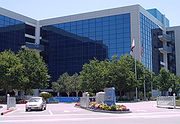Intel Corporation (NASDAQ: INTC; SEHK: 4335) is the world's largest semiconductor company and the inventor of the x86 series of microprocessors, the processors found in most personal computers. Founded in 1968 as Integrated Electronics Corporation and based in Santa Clara, California, USA, Intel also makes motherboard chipsets, network cards and ICs, flash memory, graphic chips, embedded processors, and other devices related to communications and computing. Founded by semiconductor pioneers Robert Noyce and Gordon Moore, Intel combines advanced chip design capability with a leading-edge manufacturing capability. Originally known primarily to engineers and technologists, Intel's successful "Intel Inside" advertising campaign of the 1990s made it and its Pentium processor household names.
Intel was an early developer of SRAM and DRAM memory chips, and this represented the majority of its business until the early 1990s.[citation needed] While Intel created the first commercial microprocessor chip in 1971, it was not until the creation of the personal computer (PC) that this became their primary business. During the 1990s, Intel invested heavily in new microprocessor designs and in fostering the rapid growth of the PC industry. During this period Intel became the dominant supplier of microprocessors for PCs, and was known for aggressive and sometimes controversial tactics in defense of its market position, as well as a struggle with Microsoft for control over the direction of the PC industry.[5][6] The 2007 rankings of the world's 100 most powerful brands published by Millward Brown Optimor showed the company's brand value falling 10 places – from number 15 to number 25.[7]
Contents[hide]
|
[edit] Corporate history

Intel was founded in 1968 by Gordon E. Moore (a chemist and physicist) and Robert Noyce (a physicist and co-inventor of the integrated circuit) when they left Fairchild Semiconductor. A number of other Fairchild employees also went on to participate in other Silicon Valley companies. Intel's third employee was Andy Grove,[8] (a chemical engineer), who ran the company through much of the 1980s and the high-growth 1990s. Grove is now remembered as the company's key business and strategic leader. By the end of the 1990s, Intel was one of the largest and most successful businesses in the world.[citation needed]
[edit] Origin of the name
At its founding, Gordon Moore and Robert Noyce wanted to name their new company "Moore Noyce". This name, however, sounded remarkably similar to "more noise" — an ill-suited name for an electronics company, since noise is typically associated with bad interference. They then used the name NM Electronics for almost a year, before deciding to call their company INTegrated ELectronics or "Intel" for short. However, Intel was already trademarked by a hotel chain, so they had to buy the rights for that name at the beginning.[9]
[edit] Company's evolution
Intel has grown through several distinct phases. At its founding, Intel was distinguished simply by its ability to make semiconductors, and its primary product were static random access memory (SRAM) chips. Intel's business grew during the 1970s as it expanded and improved its manufacturing processes and produced a wider range of products, still dominated by various memory devices.
While Intel created the first microprocessor in 1971 and one of the first microcomputers in 1972,[10][11] by the early 1980s its business was dominated by dynamic random access memory chips. However, increased competition from Japanese semiconductor manufacturers had by 1983 dramatically reduced the profitability of this market, and the sudden success of the IBM personal computer convinced then-CEO Grove to shift the company's focus to microprocessors and to change fundamental aspects of that business model. By the end of the 1980s this decision had proven successful, and Intel embarked on a 10-year period of unprecedented growth as the primary (and most profitable) hardware supplier to the PC industry.
After 2000, growth in demand for high-end microprocessors slowed and competitors garnered significant market share, initially in low-end and mid-range processors but ultimately across the product range, and Intel's dominant position was reduced. In the early 2000s then-CEO Craig Barrett attempted to diversify the company's business beyond semiconductors, but few of these activities were ultimately successful.
In 2005, CEO Paul Otellini reorganized the company to refocus its core processor and chipset business on platforms (enterprise, digital home, digital health, and mobility) which led to the hiring of over 20,000 new employees. In September of 2006 due to falling profits, the company announced a restructuring that resulted in layoffs of 10,500 employees or about 10 percent of its workforce by July of 2006. Its research lab located at Cambridge University was closed at the end of 2006.

No comments:
Post a Comment